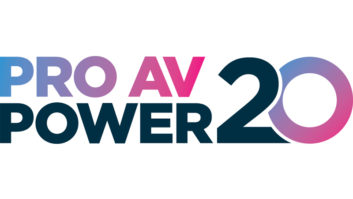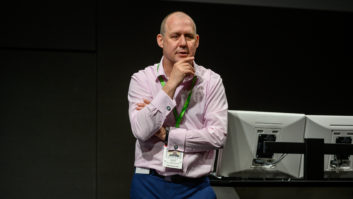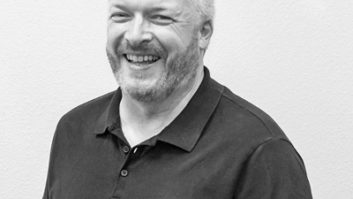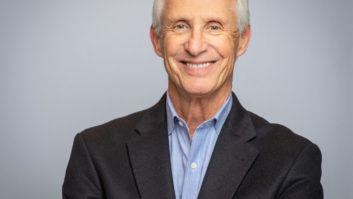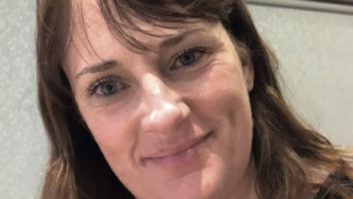#5: Christopher Jaynes, founder and CTO, Mersive Technologies
How did you first get involved in the AV marketplace?
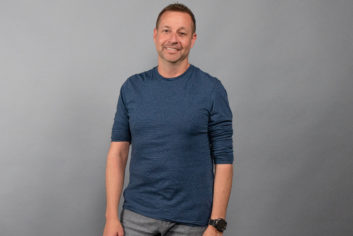 I’m an accidental transplant into the AV community. I began my career as a computer scientist – working on human-computer interaction, artificial intelligence, and computer vision technologies. I’ve always been very interested in the intersection between technology and the human experience, how we can leverage technology for human-centered goals.
I’m an accidental transplant into the AV community. I began my career as a computer scientist – working on human-computer interaction, artificial intelligence, and computer vision technologies. I’ve always been very interested in the intersection between technology and the human experience, how we can leverage technology for human-centered goals.
As part of my work, we began looking at how to replace expensive hardware-based display systems with low-cost multi-projector light arrays. We were building immersive learning labs composed of dozens of automatically aligned (using computer vision) HD projectors, and in one case, we built the highest-resolution video display in the world at the time.That led to the founding of the company. We were working to commercialise the approach for flight simulators, planetariums, and even conference rooms and ended up partnering with the AV community to bring it to market.
Once I found myself in the AV space, I quickly realised that software should play a much bigger role for users, and then introduced Solstice. I also found that the world of AV is focused on the intersection of technology and infrastructure and us; how we see/hear our environments. This became a natural home for me.
What would you say are the most significant changes/developments to have taken place in the industry during your time?
The introduction of general-purpose computing and a software-forward approach to product development has really transformed the industry over the past five years. It’s disruptive, but ultimately beneficial and is a powerful transformation for an industry that through the 80s to early 2000s was heavily focused on hardware.
This trend was originally referred to as AV/IT convergence, but it goes well beyond that. The lifecycle of software is much more rapid than hardware development cycles; this means that innovation in the AV industry has arrived at a pace that transforms the community.
This has an important side effect; it’s allowed users to become partners in developing new products. A virtual cycle of users who dream big, see their needs implemented rapidly in software, and then are willing to deploy those innovations has started. This is really exciting and has changed the way products are designed and created. It brings the user to the forefront, puts the focus on ‘experience’ and not features, and rewards innovation.
The AV community should be proud of this transformation. We, as a community, build how the world experiences the places we work, learn, and entertain ourselves.
A secondary, but equally important trend that I think is just starting is diversity of the community. That likely goes hand-in-hand with the increase in innovation and flexibility. I know we have a long way to go, but the increasing roles of a more diverse community including women, under-represented groups, and those from diverse regional backgrounds is encouraging. This is a trend that couldn’t make me happier – it ultimately leads to a healthier, more dynamic, exciting, and more successful industry.
What personal and professional achievements are you most proud of?
Hands-down, I’m most proud of building a company where people love to work. When I think about creating a place where employees can build a career and even feel fulfilled, that’s just more important than any of the awards I’ve won. Especially when I think about the families of our employees who depend on a positive work experience and the jobs that we’ve created as a team – it makes me proud.
If I had to name anything beyond that, I’d have to point out a pair of awards that, I think, reflect my focus on how science can be a powerful thing when it’s brought to bear in the ‘real world’. I am honoured that the National Science Foundation recognised me with the CAREER award as one of the major scientific contributors in my field – and to have also won the EY Entrepreneur of the Year for the Rocky Mountain region. Each of those awards are great on their own, but I’m proud that I was able to be successful in both academics and industry.
Do you have a philosophy that you live by professionally? If so, what is it and how has it benefitted your career, those around you, and the wider market?
I do. I believe that work should be meaningful and rewarding. We spend a large portion of our lives in professional pursuits and I think it’s important to acknowledge that it’s our personal responsibility to ensure this is true, both for us, our colleagues, and the larger community.
I think by seeing a meaningful career, you find work that you love. It’s allowed me to be passionate, deeply engaged, and thoughtful about what I do. That was the case when I was professor at the university and it’s certainly true in my career at Mersive.
This philosophy applies equally to the people I manage and work with as it does to me. It’s why I spend so much time on company culture. It’s why we gift employees multiple paid volunteer days to find meaning through volunteer work. I think this approach creates teams of successful people who are genuinely engaged with what we’re building. I managed a large number of students with this philosophy and it helped us build a very dynamic research program. That same philosophy has made Mersive a fun, exciting, and rewarding place to work.
I’d like to think that this approach has benefited the industry. I can’t speak to that directly, but I can say that I always look for ways to give back to the community. This is easy because I do find what I do meaningful and real – it’s certainly not ‘a job’.
To that end, I run an active blog about the AV industry. And, I have just launched a technology podcast called Tech+ that explores how technology plus people creates real impact. I volunteer to speak at many schools to advocate for the industry in the hopes that we engage with people who could, one day, join our industry. I wouldn’t be doing those things if I didn’t find the work meaningful.
Prior to the outbreak of the global pandemic, what would you say were the biggest areas of technological or operational challenge for the AV industry?
The biggest areas of challenge have been disruption, convergence, and consolidation across the industry. As software has created disruption, AV and IT have converged. This has forced parts of the industry to consolidate. While some of this ‘creative destruction’ is inevitable and even good, it’s created significant challenges for the AV industry. However, the fundamental mission and purpose of AV to enhance the human experience through technology remains as strong and important as ever. The challenge for AV is to embrace the change and take that mission to the next level. We cannot let consolidation move us to a stagnant place. Our mission is too important.
What impact has the pandemic had on you and your business, and what do you think will be the longer-term impact of this extraordinary period on our sector?
This is arguably the largest transformation of the workplace that the world has seen since the industrial revolution. Those of us working in the AV industry should acknowledge this – that we are now working in an area that is undergoing literally historic change. The AV industry was already experiencing a period of disruption. Disruption enabled by flexible software that’s replacing the traditional hardware-based, heavy-infrastructure approach to building our environments. But now, many of the things that we’ve acknowledged that are important – or require innovation – will come into sharp focus and lead to an era of new innovations unlike the AV industry has never seen.
I’m a technologist, and when I think about how the pace of innovation responds to global-scale challenges, I get pretty excited about what’s about to happen. We’re about to see things change in ways we would have only dreamed about in the past. I believe this because, historically, there are really two types of inventions: those that are almost accidental leaps; and those that arise from great need and force of will. But in reality, many of our best inventions come when we are forced, through major disruption, to come up with solutions at all costs to some very hard problems. These types of inventions require focus, an absolute need to change things quickly in response to challenges.
Some of this is hard to predict. But if I had to pick a few areas to watch, I’d name the following: touchless rooms; video conferencing for everyone/in every room; and workplace analytics and intelligence.
Touchless rooms
This is certainly a dream that’s been outlined in several futuristic movies where a conference room is driven by voice, by gesture, or even predicts what a user wants to do without the need for a clumsy touch panel, light switch, or (heaven forbid) a remote control. The pandemic will certainly accelerate innovation in this area. I’ve heard the words ‘touchless AV’ several times a day from my colleagues already.
Video conferencing for everyone/in every room
In the old days (a year ago), enterprises would deploy a ‘video enabled room’ that forced users into a certain video conferencing experience. That was okay if my need for video conferencing was specialised, elite, or so important that I was willing to figure out how to use a Zoom Room or a dedicated WebEx space. In this new world, I way want to walk into any space and reach the half of my team that’s working at home on a Slack call – or use Zoom, or Teams, or whatever I want. The room camera, audio, display, and furniture should be there for me without forcing a choice. We also need a cost structure that makes it feasible to put a camera system in every space – huddle rooms, lounges, and transitional hallways even so I can reach my colleagues at any time. Enterprise will look for ways to replace those 50 dedicated video rooms with 500 simpler, multipurpose spaces that are video capable. Look for innovation here.
Workplace analytics and intelligence
One of the things to watch is how companies will navigate this new era. Already there were a smattering of projects to equip our workplace with intelligent sensors that help us understand how we work. (Who hasn’t heard of ‘intelligent buildings’ by now.) However, while we’re trying to modify our very work pattern through policies about how to return-to-work, how to stay safe, or remain productive and engaged – the stakes have gone up. Watch for companies to find better ways to capture and mine data related to their own workplace.
What needs to change in the industry? What do we as a community need to get better at?
The opportunity facing AV is to clarify and improve the value of the workplace. This is a hard problem to solve and will require innovation and new ways of working. Fundamentally, our places of work play a critical role in our modern society and in our individual lives. AV is uniquely positioned to redefine our relationship with the workplace as the world returns to work. This will take innovation and technology that we haven’t seen before in areas from AI to workplace analytics.
In your opinion, what will be the biggest driver(s) of change for the AV market in the next five years?
It’s always hard to predict the future, but there are some clear trends that are already emerging that will change the AV industry. First, the introduction of artificial intelligence to the mainstream of AV – including control, automation, and the workplace will have profound impact. Everything from ‘smart buildings’ to virtual assistants that help us find meeting spaces, collaborate, and work together will play a more important role in AV.
I also think that AV-as-a-service – the idea that users would like to structure their financial and support relationship with the AV industry as a service – and not a product, is important. Several industry leading integrators and resellers are already introducing these ideas. Customers can benefit from a streamlined, flexible service, where ownership of hardware is no longer the focus. This has the potential to transform how AV products are sold and supported, and how customers think about their AV environments.
Finally, what would be your message to those starting out their careers in the AV community?
This is an incredible, vibrant area to work within. Don’t believe some of the bad reputation that the AV industry inherited from previous decades. The industry is responsible for one of the most interesting areas: the intersection of technology and the human experience. The community is no longer content to take a back seat to other technical industries and has the vibrancy, innovation, and excitement that is normally attributed to other fields such as AI, computer gaming, predictive analytics, and data science. The AV industry can be a rewarding and meaningful place to build a career.
Quickfire round
Who’s had the greatest influence on your career?
My graduate school PhD advisors, Ed Riseman and Allen Hanson; they instilled in me a view that science and discovery should take place in context for it to have impact. It’s probably why I started a company.
Who did/do you look up to as a role model professionally?
Dr Ruzena Bajcsy: she is the epitome of academic success that has real impact on society. Her early work in robotics and computer vision led to some of the most important breakthroughs that support things we now take for granted. At the same time, she’s given back to the community by serving at the National Science Foundation and directing the important CITRIS that focus on society and innovation. She also was a woman pioneer in a field that was heavily dominated by men. She is also a pleasure to work with and has a positive outlook.
How do you measure success?
By how the things I and my team invent have a positive impact on people’s lives.
What’s your biggest professional regret?
Probably spending too long before pivoting to Solstice. I could see the opportunity for a wireless, free experience in the meeting room, but we were already on a path and the risk of a pivot took time to accept.
If you were a teenager today, what profession would you go into?
Computational Biology. Exciting times for ‘molecular programming’.
